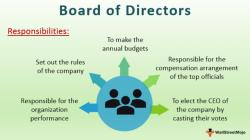What are the three levels of Management?
The three levels of management refer to the hierarchical levels of authority and responsibility in an organization. These levels represent different roles, functions, and scopes of decision-making. The three primary levels of management are:
Top-Level Management (Strategic Management):
Also known as senior management or executive management, top-level management is responsible for making strategic decisions that affect the entire organization. This level includes positions such as:
- Chief Executive Officer (CEO)
- Chief Operating Officer (COO)
- Chief Financial Officer (CFO)
- President
- Vice Presidents
Responsibilities:
- Setting overall organizational goals, objectives, and policies.
- Making major strategic decisions.
- Representing the organization to external stakeholders.
- Providing direction and vision for the organization.
Characteristics:
- Involvement in long-term planning.
- Focus on organizational vision and mission.
- Concerned with the overall success and health of the organization.
Middle-Level Management (Tactical Management):
Middle-level management is often referred to as tactical or operational management. Individuals at this level are responsible for implementing the strategies and policies set by top-level management. Positions at this level may include:
- General Managers
- Regional Managers
- Divisional Managers
- Department Managers
Responsibilities:
- Translating strategic goals into operational plans.
- Coordinating and directing activities within specific departments or divisions.
- Allocating resources effectively.
- Implementing policies and procedures.
Characteristics:
- Bridge between top-level and lower-level management.
- Involved in short-to-medium term planning.
- Focus on achieving specific departmental or divisional objectives.
Lower-Level Management (Operational Management):
Lower-level management, also known as operational or supervisory management, is responsible for overseeing the day-to-day operations and ensuring that tasks are carried out efficiently. Positions at this level include:
- Supervisors
- Team Leaders
- Frontline Managers
- Shift Managers
Responsibilities:
- Directing and supervising employees.
- Assigning tasks and responsibilities.
- Ensuring that daily operations run smoothly.
- Reporting performance and issues to middle-level management.
Characteristics:
- Closest to the day-to-day activities.
- Involved in short-term planning and execution.
- Focus on achieving specific tasks and goals.
The three levels of management form a pyramid, with top-level management at the apex, middle-level management in the middle layers, and lower-level management at the base. This hierarchical structure helps in the efficient flow of information, decision-making, and coordination within an organization. Each level plays a crucial role in the overall success and functioning of the organization.
The three levels of management in organizational structures are:
- Top-level management (also known as executive management or senior management)
- Middle-level management
- Supervisory-level management (also known as first-line management)
Responsibilities and roles
- Top-level management: Top-level management is responsible for the overall vision and strategy of the organization. They set long-term goals, develop policies and procedures, and allocate resources. Top-level managers typically have many years of experience and a deep understanding of the industry in which the organization operates.
- Middle-level management: Middle-level management is responsible for implementing the plans and strategies developed by top-level management. They oversee the day-to-day operations of the organization and manage teams of employees. Middle-level managers typically have a few years of experience in their field and a good understanding of the specific needs of their team and department.
- Supervisory-level management: Supervisory-level management is responsible for supervising the work of employees and ensuring that they are meeting their goals. They provide training and support to their team members and help to resolve any problems that arise. Supervisory-level managers typically have a few years of experience in their field and a good understanding of the specific tasks and responsibilities of their team members.
Skills and competencies
Each level of management requires a different set of skills and competencies. Top-level managers need to have strong strategic thinking and leadership skills. Middle-level managers need to have good organizational and communication skills. Supervisory-level managers need to have strong technical skills and the ability to motivate and coach their team members.
Here is a table summarizing the responsibilities, roles, and skills and competencies associated with each level of management:
| Level of Management | Responsibilities | Roles | Skills and Competencies |
|---|---|---|---|
| Top-level management | Set long-term goals, develop policies and procedures, and allocate resources. | Oversee the overall operations of the organization. | Strategic thinking, leadership, communication, and financial management skills. |
| Middle-level management | Implement the plans and strategies developed by top-level management, oversee the day-to-day operations of the organization, and manage teams of employees. | Act as a liaison between top-level management and first-line management. | Organizational and communication skills, as well as a good understanding of the specific needs of their team and department. |
| Supervisory-level management | Supervise the work of employees and ensure that they are meeting their goals, provide training and support to their team members, and help to resolve any problems that arise. | Act as the front-line managers of the organization and interact directly with employees. | Technical skills, the ability to motivate and coach their team members, and a good understanding of the specific tasks and responsibilities of their team members. |
It is important to note that the lines between the three levels of management are not always clear-cut. In some organizations, there may be more than three levels of management, or the responsibilities of different levels may overlap. Additionally, the skills and competencies required for each level of management may vary depending on the size and structure of the organization.












